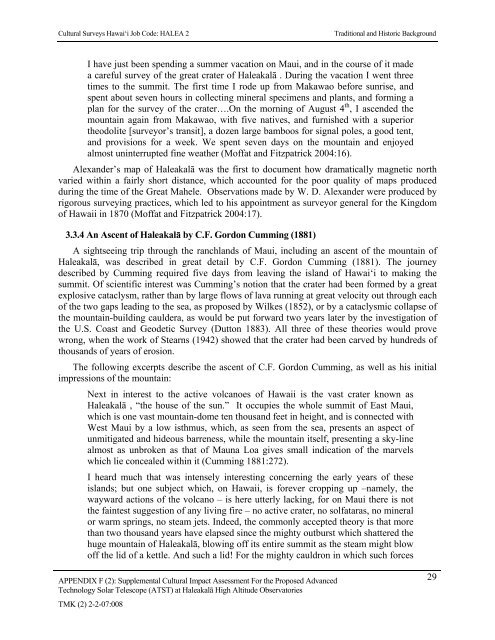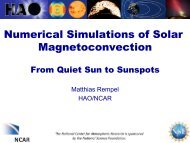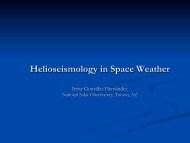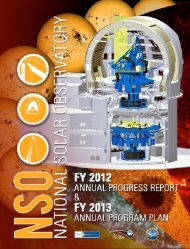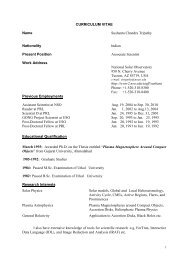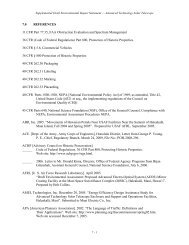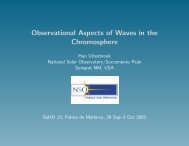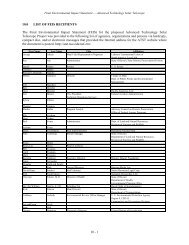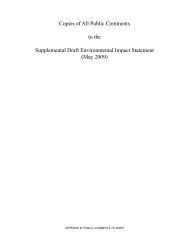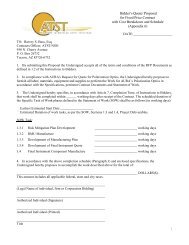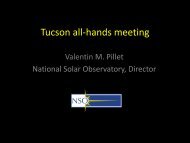F2 - ATST
F2 - ATST
F2 - ATST
You also want an ePaper? Increase the reach of your titles
YUMPU automatically turns print PDFs into web optimized ePapers that Google loves.
Cultural Surveys Hawai‘i Job Code: HALEA 2Traditional and Historic BackgroundI have just been spending a summer vacation on Maui, and in the course of it madea careful survey of the great crater of Haleakalā . During the vacation I went threetimes to the summit. The first time I rode up from Makawao before sunrise, andspent about seven hours in collecting mineral specimens and plants, and forming aplan for the survey of the crater….On the morning of August 4 th , I ascended themountain again from Makawao, with five natives, and furnished with a superiortheodolite [surveyor’s transit], a dozen large bamboos for signal poles, a good tent,and provisions for a week. We spent seven days on the mountain and enjoyedalmost uninterrupted fine weather (Moffat and Fitzpatrick 2004:16).Alexander’s map of Haleakalā was the first to document how dramatically magnetic northvaried within a fairly short distance, which accounted for the poor quality of maps producedduring the time of the Great Mahele. Observations made by W. D. Alexander were produced byrigorous surveying practices, which led to his appointment as surveyor general for the Kingdomof Hawaii in 1870 (Moffat and Fitzpatrick 2004:17).3.3.4 An Ascent of Haleakalā by C.F. Gordon Cumming (1881)A sightseeing trip through the ranchlands of Maui, including an ascent of the mountain ofHaleakalā, was described in great detail by C.F. Gordon Cumming (1881). The journeydescribed by Cumming required five days from leaving the island of Hawai‘i to making thesummit. Of scientific interest was Cumming’s notion that the crater had been formed by a greatexplosive cataclysm, rather than by large flows of lava running at great velocity out through eachof the two gaps leading to the sea, as proposed by Wilkes (1852), or by a cataclysmic collapse ofthe mountain-building cauldera, as would be put forward two years later by the investigation ofthe U.S. Coast and Geodetic Survey (Dutton 1883). All three of these theories would provewrong, when the work of Stearns (1942) showed that the crater had been carved by hundreds ofthousands of years of erosion.The following excerpts describe the ascent of C.F. Gordon Cumming, as well as his initialimpressions of the mountain:Next in interest to the active volcanoes of Hawaii is the vast crater known asHaleakalā , “the house of the sun.” It occupies the whole summit of East Maui,which is one vast mountain-dome ten thousand feet in height, and is connected withWest Maui by a low isthmus, which, as seen from the sea, presents an aspect ofunmitigated and hideous barreness, while the mountain itself, presenting a sky-linealmost as unbroken as that of Mauna Loa gives small indication of the marvelswhich lie concealed within it (Cumming 1881:272).I heard much that was intensely interesting concerning the early years of theseislands; but one subject which, on Hawaii, is forever cropping up –namely, thewayward actions of the volcano – is here utterly lacking, for on Maui there is notthe faintest suggestion of any living fire – no active crater, no solfataras, no mineralor warm springs, no steam jets. Indeed, the commonly accepted theory is that morethan two thousand years have elapsed since the mighty outburst which shattered thehuge mountain of Haleakalā, blowing off its entire summit as the steam might blowoff the lid of a kettle. And such a lid! For the mighty cauldron in which such forcesAPPENDIX F (2): Supplemental Cultural Impact Assessment For the Proposed Advanced 29Technology Solar Telescope (<strong>ATST</strong>) at Haleakalā High Altitude ObservatoriesTMK (2) 2-2-07:008


